Methods for Evaluating Visor Anti-Fog Treatments
In the most recent webBikeWorld anti-fog treatment comparison article, we discovered that the anti-fog treatment applied to the visor during manufacturing can have an affect on the anti-fog coating applied by the owner.
That is something we hadn’t considered in the past.
In response to that article, several readers suggested using a thin layer of dishwashing liquid as an effective anti-fog treatment. This is spread on the inside of the visor and then buffed dry.
I asked Dr. David Salter, the Managing Director of Salclear, about the use of dishwashing liquid as an anti-fog treatment.
We exchanged a series of emails that covered some interesting information regarding anti-fog coating evaluations with Salclear and other products that I thought might be of interest to our readers.
I have edited the various topics of the correspondence and we’re presenting it here.
Note that we have no financial interest in Salclear products, which are featured in the graphs, but the descriptions of the various methods for evaluating anti-fog treatments and coatings are both interesting and useful.
Continuing with our tests of anti-fogs and visors, we thought you’d be interested in these observations.
A simple test that we carry out on anti-fogs is our so called “Mug Test”.
See the photo below; basically we take a cup of boiling hot water and place the helmet over the cup with the visor closed.
Typically the visor will fog up within about 30 seconds as the humidity rises in the confines of the helmet.
This test is not rigorous enough to run test comparisons between different anti-fogs on an extended test basis.
But it serves to demonstrate a basic anti-fog performance parameter (for webBikeWorld evaluations).
We are aware that most visors and most plastic eyewear comes with a factory coated anti-fog layer.
We’ve demonstrated in the past that these anti-fog coatings do not, in our opinion, provide adequate anti-fog characteristics.
They are far inferior to our own spray or droplet applied products.
The second photo shows a visor in which we removed part of the factory applied anti-fog coating from, then we used the “Mug Test”. The visor shows three distinct parts, left to right:
-
Far Left: Anti-fog layer removed.
-
Central Portion: Salclear TT.
-
Far Right: Standard visor (with factory applied coating).
The worst fogging is seen on part of the visor with the factory applied coating removed. The second worst fogging comes from where the visor remains coated with the factory applied product.
The clear central portion of the visor has been treated with Salclear TT.
This test serves to demonstrate that factory applied coatings are more effective than no coating at all, but far inferior to designer anti-fog sprays such as Salclear TT.”
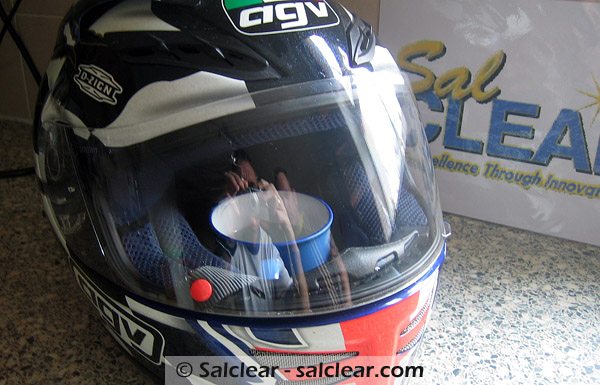
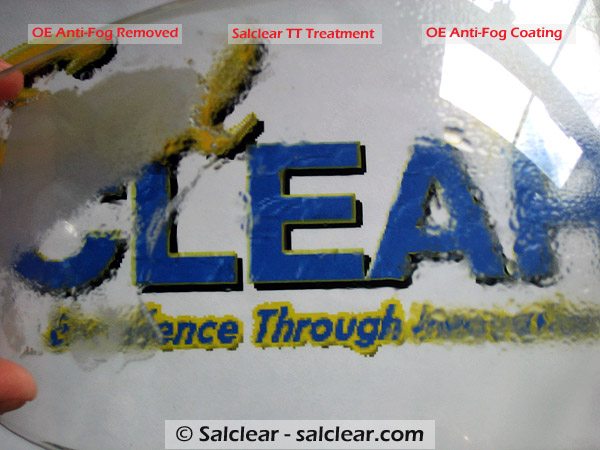
Anti-Fog Humidity and Water Resistance
We are doing some studies for a UK bike magazine and thought that the results might be of interest to you, and perhaps your readers.
The results are not complete yet, as there are other tests in progress, but it gives you a fair overview on the performance of various commercial anti-fogs for motorbike visors.
We’ve tested various commercially available products, one or two that are available in the U.S. and which you’ve looked at yourselves.
The two criteria we treat as important in selecting a good anti-fog are:
- Humidity Resistance: basically how well the anti-fog stands up to humidity and therefore fogging.
- Water Resistance: how the anti-fog behaves when subjected to high levels of condensation.
I should add that in our opinion, this wash-off test is critical. An anti-fog works by preventing water droplets forming on the inside of the visor. Instead, the water forms a completely transparent film.
Nevertheless, condensation and water filming is still present on the visor surface, and so a good anti-fog should be able to withstand the condensation and fogging that it is designed to prevent.
We regard these criteria as important because the tests illustrate anti-fog performance and anti-fog longevity (i.e., how long it lasts, and therefore by inference, its cost of use).
The data presented here is pretty self explanatory. We included in the tests:
- 6 commercially available anti-fog treatments;
- 2 Salclear products (TT and DMist);
- Liquid dishwashing detergent concentrate.
The Salclear products score highest in both tests.
And the differences are remarkable in both the humidity resistance test, where both Salclear products are at least 11 times more effective than a leading U.S. brand.
And in the wash resistance test where after 10 rinses in cold water, the U.S. product was completely ineffective, whereas the Salclear products were still 100% active.
Humidity Resistance Test
The graph below indicates time (in seconds) to 50% fogging.
Yes, these numbers are in seconds, the problem being that some anti-fogs don’t last more than 5 or 10 seconds in steam, whereas good ones last much longer.
It’s a tough test and requires the treated visor to be suspended in steam over an extended period of time.
In this test — which we created, I don’t think anyone else does it — the visor is visibly monitored until 50% of its inside surface has fogged up, a point at which we deem unacceptable to the motorbike rider.
If the rider has lost 50% of vision, that’s not a good thing!
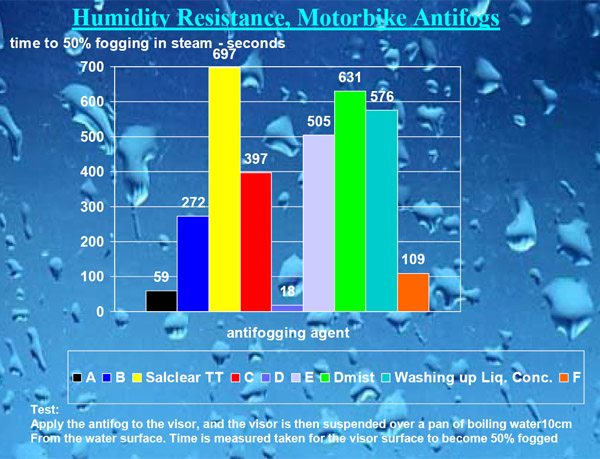
Water Immersion Test
The second test, illustrated in the graph below, relates to the water resistance of the anti-fog.
A quality anti-fog will resist water, or condensation, and therefore by definition, be resistant to the thing that its preventing, i.e., fogging or condensed water.
What use is an anti-fog that gets washed away by exactly the thing that it is preventing: fog?
The second reason for looking at this property is that visors leak, and it would be a lot of hassle to have to reapply an anti-fog every time your visor leaked in rainwater.
Another reason might be that some riders at low speed run with their visor up. In light showers a good anti-fog would not be washed away by the rain.
This data is really showing the key properties of Salclear products — they are not water soluble.
So dunking a treated visor in water often removes normal anti-fogs, as the data shows, whereas with ours the Salclear products remain 100% active and effective even after 10 complete submersions in water.
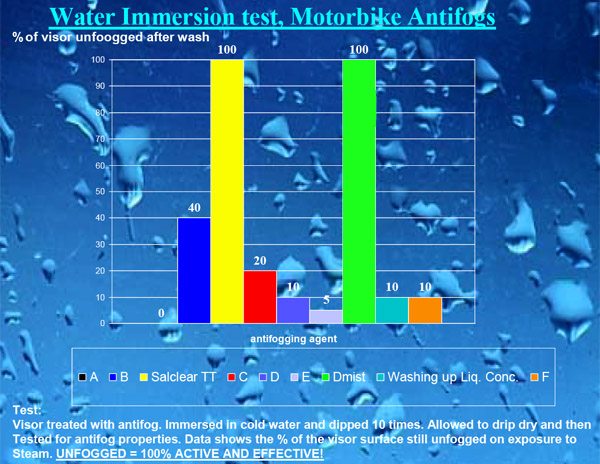
Degrease Test
The graphic below represents a “degrease” test that we also perform.
This is a typically “over the top” test that we normally conduct; in other words, when we test our products, we don’t just pick a test that is easy to pass.
We smeared half the inside of a visor with Vaseline petroleum jelly/wax. Why do this?
Well, the majority of anti-fogs you can buy are just anti-fogs — that’s all they do.
We wanted to create a product that was multifunctional, and we decided that it would be better to create an anti-fog AND cleaner/degreaser in the same product.
So the biker does not have to buy a separate product to remove squashed bugs or finger marks from the visor.
So this test evaluates how good current commercial anti-fogs are at both degreasing AND defogging.
And we tested the defogging AFTER the degrease test just to show that the anti-fog performance is not badly affected by the degrease test.
In the data above, you are looking for “+ +” in the degrease/defog test.
A “-” degrease and “+” defog means that it left the visor messy with grease, but still worked adequately as a defog.
A “-” degrease “-” defog means that it failed both tests.
A “+” and “+” obviously means that it cleans very well, and acts well as an anti-fog.
Examples: Salclear TT, Salclear Dmist, dishwashing liquid and anti-fog brand C (but note in the other tests that anti-fog C has modest/good humidity resistance, but poor wash off resistance).
In summary, apart from the Salclear products, only normal dishwash liquid performs well in all of these tests, which is pretty sad considering the number of so called motorbike anti-fogs on the market!
By the way, we are always happy to look at any other tests that your customers/readers would think of as being appropriate.
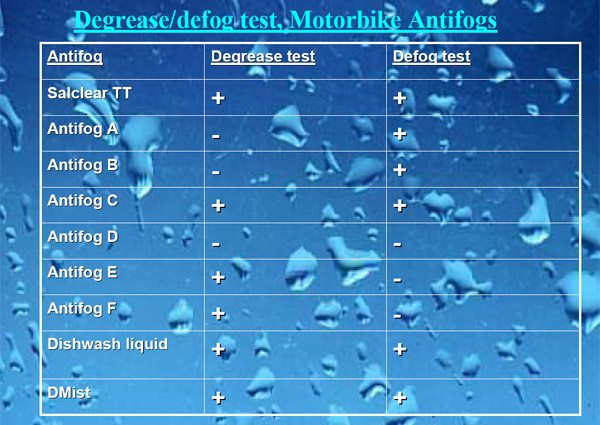
Dishwashing Liquid Anti-Fog and the Smear Test
You are right about the dishwashing fluid — many motorcycle riders (and scuba divers) use it. Giving it a good buff works.
We did not include this in the mirror smear test, but you’ll find that any mirror with buffed up dishwashing liquid is a real mess; I’d guess it would score a 5 after buff.
You’d get all sorts of streaking and weird colours.
Scuba divers (bearing in mind that this is another core market for us), often claim that dishwashing liquid is good, except when they get water in their masks and then it drips in their eyes!
Dishwashing liquid degreases frying pans very well, but not sure about eyeballs…
One other thing we need to consider: smear.
We’ve already demonstrated that dishwashing liquid is a good overall performer — a good degreaser, a good anti-fog, good steam resistance.
But dishwashing liquid and other thick gloopy anti-fog products may have poor smear characteristics.
They perform ok, but make the visor look terrible.
What’s the point in having a good defog, if when you apply it, it makes your visor streaky, smeared and messy? So we looked at smear characteristics, illustrated in the graphic above.
We tested initial smear and after buff/wipe/polish smear on a mirror.
The mirror bit is important because any blemishes or streaking are far easier to see on a clean mirror than a curved plastic visor.
Here’s what we found: The initial application of most defogs scores low; nearly all are messy.
A spray product, such as Salclear TT scores high, because it spreads wide and thinly. After buffing or polish, some spread well and the streaking disappears or is reduced
We marked the cleanliness of the surface of the mirror out of 10, so 10/10 is perfect. Something like 5 or 6 is quite badly smeared.
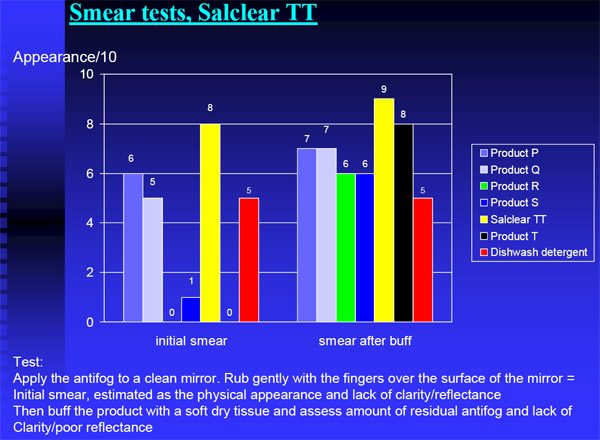
Squashed Bugs Test
We also discussed the “squashed bugs” test.
We mix fat (butter), carbohydrate (honey), protein (minced beef) and smear it on a visor and bake it in the oven for 15 minutes to dry it on the visor.
All this just to test if our products get rid of squashed bugs!
Conclusion
So to summarise, as a producer we think the consumer, our customers, need to consider several performance characteristics in their visor treatment:
- Anti-fog performance.
- Cleaning capabilities.
- Wash-off resistance.
- Humidity resistance.
- Smear/streaking.
Our tests are tough, but nothing so far that we looked at came close to Salclear TT. Perhaps that’s why it’s the product of choice by racers in the TT races!
More wBW: Anti-Fog Treatment Reviews | Heated Clothing Reviews
Owner Comments and Feedback
See details on submitting comments.

